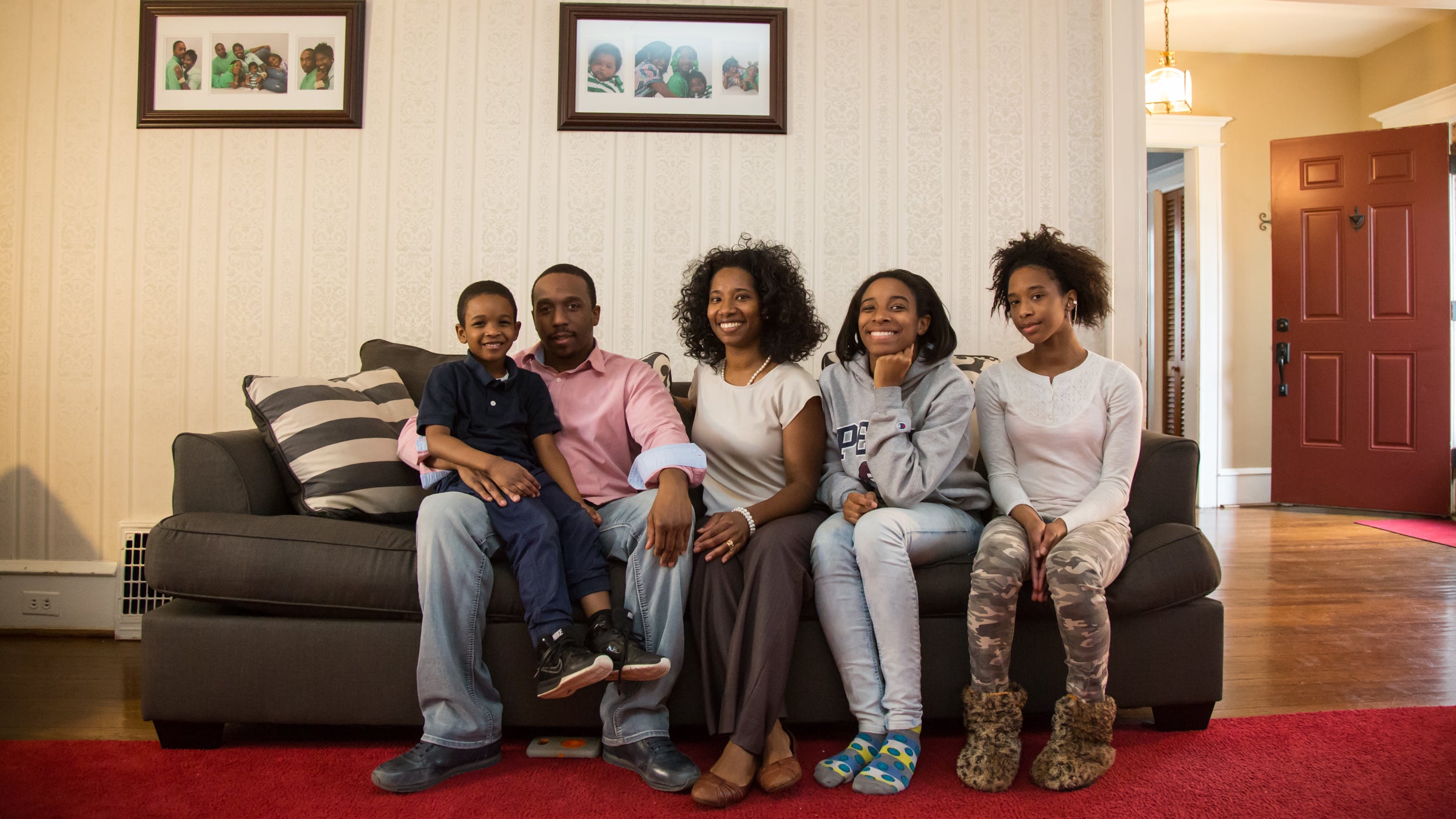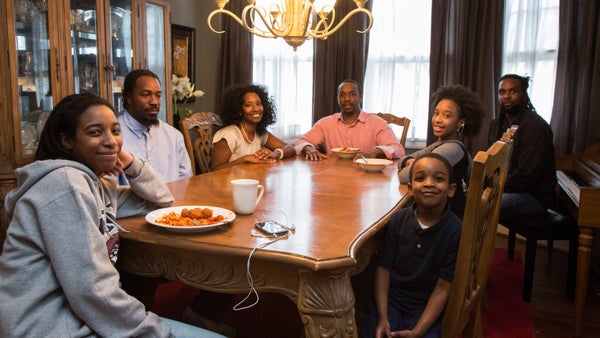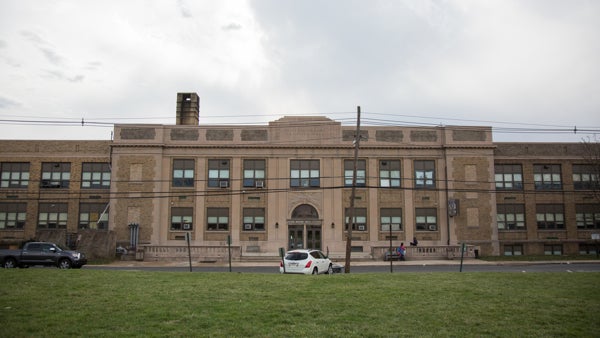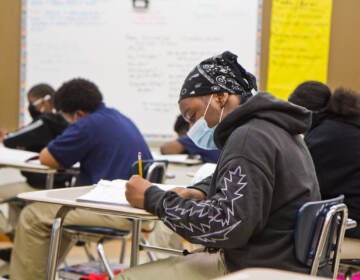The cold realities of education in a poor Pennsylvania school district
Listen
The Miller family sits in the living room of their Landsdowne home in 2016. (Emily Cohen for WHYY)
This story is part of the NPR reporting project “School Money,” a nationwide collaboration between NPR’s Ed Team and 20 member station reporters exploring how states pay for their public schools and why many are failing to meet the needs of their most vulnerable students.
This winter, high school junior Jameria Miller would run to Spanish class. But not to get a good seat.
“The cold is definitely a distraction,” Jameria says. “We race to class to get the best blankets.”
Because the classroom has uninsulated metal walls, Jameria’s teacher would hand out blankets. First come, first served. Such is life in the William Penn School District – an impoverished, predominantly African-American school system situated among Philadelphia’s inner-ring suburbs.
The hardest part for Jameria isn’t the cold, though. It’s knowing that life isn’t like this for students in other districts.
“It’s never going to be fair,” she says. “They’re always going to be a step ahead of us. They’ll have more money than us, and they’ll get better jobs than us, always.”
Before her parents moved, Jameria was one of those students. She attended classes in the more affluent Upper Moreland district in nearby Montgomery County. That system is largely white and, according to state and local records, spends about $1,200 more per student than William Penn.
That funding difference adds up to better facilities, smaller class sizes, take-home textbooks, and better teacher pay with less turnover. Upper Moreland is also able to set aside money each year for a rainy day fund. William Penn has been spending beyond its means just to get by.
Jameria’s mother, Jamella, says her oldest daughter’s time in wealthier Upper Moreland made a huge difference, academically — an advantage her younger daughter did not have.
“Because of [Jameria’s] foundation there, she’s able to excel. Whereas, students like my younger one, who started off here, she kinda just plateaued instead,” Jamella says.
The Millers chose to leave Upper Moreland and move closer to Philadelphia because they needed more living space to accommodate their large, extended family.
“When family need a place to stay, or have a rough patch, they pretty much come stay with us,” Jamella says.
 Jameria Miller sits at the dining table with her parents, siblings and uncles. (Emily Cohen for NewsWorks)
Jameria Miller sits at the dining table with her parents, siblings and uncles. (Emily Cohen for NewsWorks)
Sitting around the dining table in their Delaware County home, Jamella and her husband, Bryant, admit that, when they bought their current house, they knew the public schools weren’t great. So they had a plan.
“We thought we would be able to put our kids in private school. But we had some things that came up. You lost your job,” she says to Bryant. “I lost my job. So, financially, it became hard.”
Both are working again but say private tuition payments are still beyond their means. Bryant says he sometimes wishes they had opted for a smaller house in a better-resourced district.
“Having children is all about sacrifice, so sometimes I wish we would have went smaller,” he says. “I really do.”
Why does one school district have so much less to spend than another just 20 miles away?
A few answers.
First, in Pennsylvania, as in many other states, local property taxes make up a big chunk of the money schools have to spend on their students. If your community is property-poor, that means less property tax revenue for your schools.
There’s also a paradoxical stress for families in districts like William Penn. Compared to some wealthier districts, they may actually have higher property tax rates. But, because high rates in a property-poor area won’t raise the same amount of revenue as lower rates in a more affluent area, their schools still struggle.
“It just spirals out of control,” Jamella says. “And then the district took out a loan to try to fix certain schools that were just falling apart, and now the taxes are going up another 3 percent this year. It’s just a continual spiral.”
To slow the spiral, many states send extra dollars to their low-wealth districts. But Pennsylvania ranks near the bottom of all states for how little it kicks in.
And then there’s the state legislature.
Lawmakers decide how to divvy up that state cash but historically haven’t considered important factors like the number of students living in poverty or learning English. If they did, districts like William Penn would see a big boost. In the meantime, the state’s funding system is profoundly imbalanced, with predominantly white districts getting more per-student aid from the state than equally poor districts with more students of color.
 Penn Wood High School in the William Penn district. (Emily Cohen for NewsWorks)
Penn Wood High School in the William Penn district. (Emily Cohen for NewsWorks)
A recent Associated Press analysis found that the state’s richest 20 percent of districts spend an average of about $4,000 more per student than the poorest 20 percent of districts. In 2015, then-U.S. Education Secretary Arne Duncan called for state lawmakers to shrink that gap.
“The children who need the most seem to be getting less and less,” Duncan said while on a visit to Pennsylvania. “And the children who need the least are getting more and more.”
In an attempt to force changes at the state level and make education spending more equitable and adequate, Jamella and her family have joined a lawsuit against the state.
“Why wouldn’t you want to provide all students with all the same tools to ensure that they would be able to meet those goals?” she says.
The suit, which includes the William Penn district itself along with a broad coalition of other plaintiffs, alleges that the state has failed its constitutional responsibility to provide all children a “thorough and efficient” education. The state Supreme Court is expected to hear the case later this year.
In the meantime, Gov. Tom Wolf, a Democrat in his second year in office, is pushing hard for massive new state investments in public education meant to ease the burden on property-poor districts.
But that would require broad-based tax hikes, which the Republican-controlled House and Senate oppose. House Education Committee Chairman Stan Saylor says, instead of focusing on new money, district leaders can and should do a better job of spending the money they have.
“It’s not about the dollars. It’s where that local school district spent those dollars over the last many years,” Saylor says. “We need more aggressive administrators, principals and superintendents who can tailor education in whatever particular school district it is to what the needs of that school district are.”
Brandon Cooley, the principal of Jameria’s Penn Wood High School, insists they’re doing the best they can with what they have.
“I’d urge any lawmaker to come here and actually see the work we’re doing and the challenges that we face,” Cooley says. “I think they’d leave with a much different impression.”
Last year’s state budget – which fell short of Wolf’s proposed increases by half – arrived nearly nine months past deadline. Because of the delay, many school districts had to take out loans to keep up operations. Some feared they wouldn’t have enough cash to get through the year. And the coming budget cycle could bring yet another painful, political stalemate.
Whatever happens, Jameria says, this fight over fairness in school funding has taught her a lesson she’ll never forget.
“What I’m about to say might not be very nice,” she says, “but rich people aren’t going to want [funding fairness]. They want their kids to have better things so that their kids can get a jump start in life and be ahead of everyone else. And, as long as people feel that way, we all won’t be equal. We won’t receive equal education ever, because education is what gets you success.”
WHYY is your source for fact-based, in-depth journalism and information. As a nonprofit organization, we rely on financial support from readers like you. Please give today.





